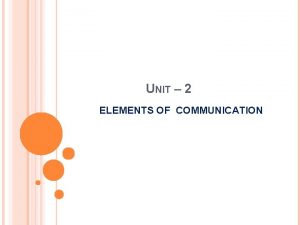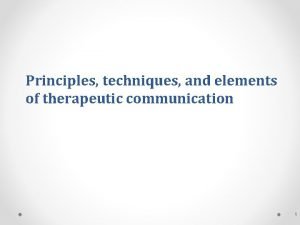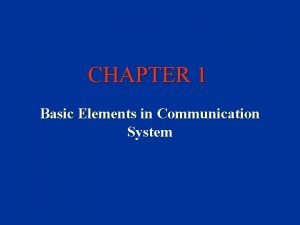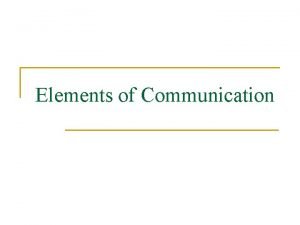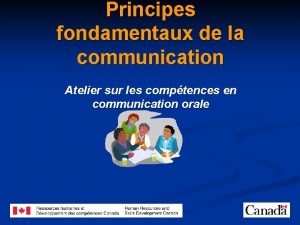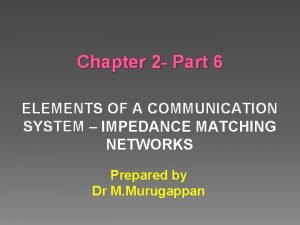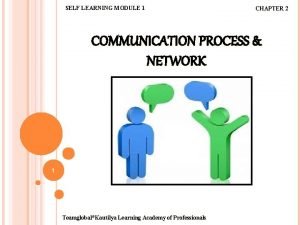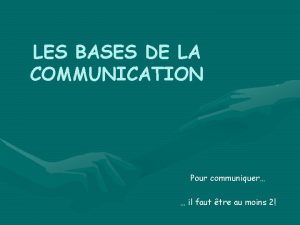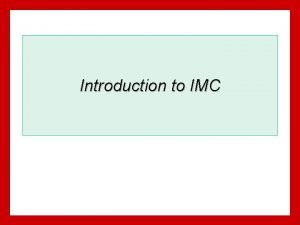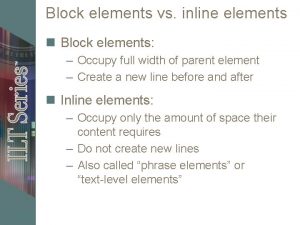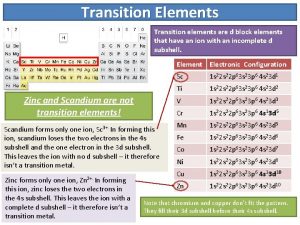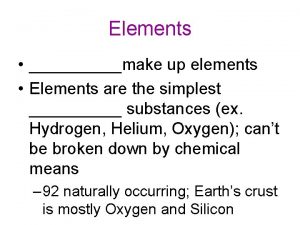Elements of Communication Elements of Communication 6 Elements






















- Slides: 22

Elements of Communication

Elements of Communication 6 Elements of Communication 1. Verbal messages 2. Nonverbal messages 3. Perception 4. Channel 5. Feedback 6. Context

Elements of Communication 1. Verbal Messages Verbal messages are spoken words you use when communicating

Elements of Communication 1 a. Verbal Messages Most children begin to use words by the time they are 10 -14 months old Words do not have the same meaning for everyone Also words change their meanings over time…can you think of an example? Communicators need to know how to select the most exact words to get their messages across accurately

Elements of Communication 1 b. Verbal Messages Differences in meaning: Not all words mean the same thing to all people Interact: With a small group of 3 or 4 people list the possible meanings of the following words or phrases See you later Expensive Tall Free Hot Bad Party What’s on Friday night? What a day! She is bad.

Elements of Communication 1 c. Verbal Messages Denotative meaning of words The definition of a word found in a dictionary Connotative meaning of words An emotional or personal response to a word For example: home-denotative meaning is one’s place of residence ----home-connotative meaning is security Everyone’s connotative meaning for words will be different

Elements of Communication 2. Nonverbal Messages Nonverbal messages are messages expressed without words a. Appearance b. Facial expression & eye contact c. Posture d. Gestures e. Voice

2 a. Appearance If you needed to ask someone for directions, who would you ask first? An old man in dirty clothes A cute teenage boy or girl A woman with an infant Or a woman in a sari

2 a. Appearance Clothes, body size, hairstyle, makeup, and decorations such as jewelry or slogan buttons all send messages about how a person sees herself or himself You probably make quick first judgments about others based on appearance So that means that others make first judgments about you based on your appearance

2 b. Facial Expression & Eye Contact Smiles or frowns tell others a great deal about how a person is feeling A person’s face often reveals rather quickly that a person is angry, happy, frustrated, or nervous What is a look that tells you not to bother your parent? Most people believe the eyes are the most expressive part of the body Eyes show feelings that might be hidden otherwise You can learn a lot from a person’s willingness or unwillingness to look at you

2 c. Posture & Walk Posture refers to your body’s position as you sit, stand or walk The way you sit or stand communicates a great deal about your mood or feelings If you are slouching, you create a very different image than if you are standing or sitting up straight

2 c. Posture & Walk Posture can also send other messages Models are taught to “walk tall” to make good impressions Persons interviewing for jobs are taught to stand sit up straight because they will seem more confident Interviewers usually notice people’s posture while they talk with them about their qualifications

2 c. Posture & Walk The way you walk also sends nonverbal messages to others When you watch people walking slowly & dragging their feet, you might decide they are reluctant to get to where they are going When you see people walking briskly, you may conclude they are anxious to get somewhere

2 d. Gestures The way people move their arms, hands, and fingers plays a part in communication Most good speakers use gestures to help make a point Besides large gestures, people use hand signals to communicate Think of the different meanings of the peace sign, the OK sign, or crossed fingers Can you think of other gestures that are used to send a message?

2 e. Voice A person’s voice, that is, not what is said but how it is said, conveys important messages Voice includes Pitch-how high or low the tone of voice is Rate-how quickly or slowly something is said Vocal quality-the tone or sound of a voice Volume-the loudness or softness of a voice

Elements of Communication 3. Perception The process of giving meaning to information you learn through your five senses: taste, touch, hearing, sight, and smell provide you with information about the world

Elements of Communication 4. Channels of Communication In communication terms, the channel is the means by which a message is transmitted

Examples Television E-mail What are some other channels of communication?

Elements of Communication 4 a. Channels of Communication People tend to place greater importance on 1 channel than on another Example: if you are talking on the phone and watching tv, you tend to place greater importance on only 1 of those. You can’t truly focus on both

Elements of Communication 4 b. Channels of Communication When a person has trouble understanding a message, there is said to be noise in the channel Noise is anything that interferes with a listener’s ability to receive a message Could be outside the person (tv, radio, hard chair) Could be inside the person (a headache, worries, boredom) Sometimes you can control the noise (turn down music and sometimes you can’t)

Elements of Communication 5. Feedback Positive and Negative Feedback Positive feedback tells you that you’re doing fine (a smile, nod of the head, all indicate that you are getting through as you intended) Negative feedback tells you there is a problem to deal with or lets you know the listener does not agree with your ideas It is important to recognize whether a listener is confused or whether a listener is disagreeing Communication goes smoothly when speakers & listeners pay attention to feedback

Elements of Communication 6. Context Finally, all these essential elements of communication come together within a context Context is the setting and people that surround the message Setting involves time, place, and occasion You may something at a certain place or time that you wouldn’t say at another place The people in the setting influence what is said and what is not said The way you see the setting and the other people involved will affect how you handle certain topics
 Parallel vs serial communication
Parallel vs serial communication What is oral communication and written communication
What is oral communication and written communication Serial and parallel interface in microprocessor
Serial and parallel interface in microprocessor Mass communication
Mass communication Oral communication conclusion
Oral communication conclusion Serial communication vs parallel communication
Serial communication vs parallel communication 2 elements of communication
2 elements of communication Elements of therapeutic communication
Elements of therapeutic communication What is mass
What is mass Two step flow of communication model
Two step flow of communication model Retail communication mix in retail management
Retail communication mix in retail management What are the basic elements of communication system
What are the basic elements of communication system Context in elements of communication
Context in elements of communication Les principes de la communication efficace
Les principes de la communication efficace Elements of communication process
Elements of communication process Communica definition
Communica definition 6 elements of communication
6 elements of communication Communication process and elements
Communication process and elements Quelles sont les bases de la communication ?
Quelles sont les bases de la communication ? Process of communication
Process of communication Which elements of a play are considered technical elements?
Which elements of a play are considered technical elements? Elements and sub elements
Elements and sub elements Molecular element
Molecular element






